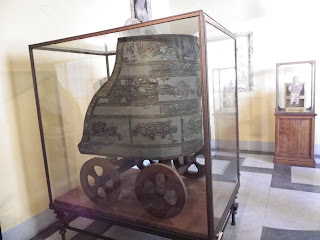Once again, I apologize for the lapse in blogs. While traveling the last thing on my mind is blogging, just thinking of what I will write. Working hard to fill in the gaps.
So for today I of course had class, and we visited what was one of the nicest museums and solely dedicated to Roman historical artifacts.
You may remember this picture, from my first day in Rome. The building in the background and flanking both sides is called the Capitoline Museum. They have not always been museums, in the past centuries they were the center of political Rome. Directly behind this building are the ancient ruins and you would also be able to see the Colosseum.
Man this picture already seems like a lifetime ago. I even had shorter hair then haha.
These are the remnants of a colossal statue of the Emperor Constantine. He was known as the first Emperor to accept Christianity, and is quite well known and loved for that.
The remnants of this statue were found in a nearby basilica that had been looted and recycled throughout. To help visualize the size of this statue in Ancient Rome, a 6'0 man would stand almost a foot shorter than the arm that is on the left if you are looking at the statue.
This is one of many 12 foot tall engravings that would have mounted one of the dozens of triumph arches that were erected in Ancient Rome. As previously mentioned, there would be a triumph parade for any major victory. In the Ancient Roman Empire, victories were plentiful, thus arches were as well.
This is a triumph parade during the time of Emperor Marcus Aurelius ruled(161-180AD). The arches were not actually erected in time for the victory parades, temporary ones were in place then torn down. The real arches were built afterwards encompassing the images of the victory parade.
This is the oldest and probably my favorite statue in all of Roman history. As I have mentioned before, of course this is a statue of the She-Wolf raising the twins Romulus and Remus.
As the legendary story goes, the God of War, Ares(known as Mars, pictured below) wanted to have children. A beautiful young woman, Rhea Silvia was forced to mother children by the God of War. Rhea Silvia was a Vestal Virgin, a very prominent and prestigious group of women who were beautiful and bound to celibacy.
They had two sons, Romulus and Remus. Because of the expectations of a Vestal Virgin in the position of Rhea Silvia, the twins were ordered to be killed by men. Romulus and Remus were brought to the Tiber river by a servant, who could not bear to kill the young twins. He instead abandoned them.
This is when a she-wolf found the twins and cared for them for a few years in a cave. She nurtured the twins Romulus and Remus until they were big enough and a Shepard found them. The twins grew strong together and became well known. The twins had the vision to create a great city, but the two differed on the location. Romulus wanted it near where they were born, while Remus wanted it elsewhere. In any version of the legend, Remus either dies or is killed. Romulus then founds the city of Roma and so prospers a great empire. (Look for day 26 for founding point)
So that is the most popular and my favorite story of the founding of Rome, and has been popular for several thousand years.
Moving on, this is a detailed chariot used in wartime activities. Thought it was preserved pretty well and would include it.
This is a statue of Marcus Aurelius that was originally outside the Capitoline Museum(look at first picture in todays blog) but had to be moved to avoid deterioration. Originally it was shown with barbarians or peasants below, and Marcus Aurelius was forgiving and blessing them. That part has been removed several hundred years ago.
Just finishing up on a large and extremely rare statue that once belonged to Julius Caesar. To show that Roma had a strong but fair military aspirations, the enemy was always shown in valor defeat. This is the original, and no duplicates exist, of a young enemy soldier who was stabbed and is nearing defeat in death. It was found at a villa of Julius Caesar in immaculate condition. These all point to ideas that it was the personal belonging of Julius Caesar.
Well I hope you all enjoyed this blog, and appreciate every view I get. Feel free to invite your friends to read or anyone, as I hope I can express what I am seeing and have others develop the appreciation for Ancient Rome that I have. Thank you all! Tune in tomorrow's for the Netherlands!








Nessun commento:
Posta un commento